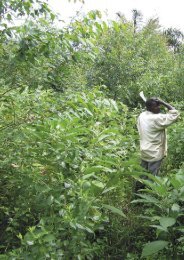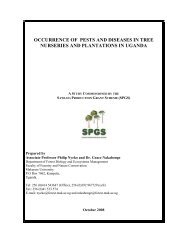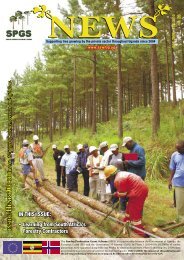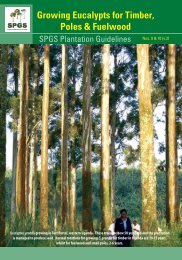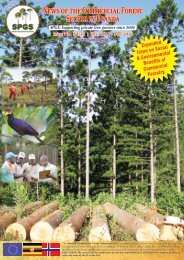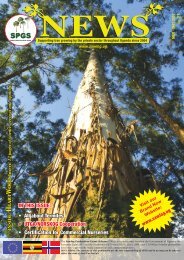download - SPGS
download - SPGS
download - SPGS
Create successful ePaper yourself
Turn your PDF publications into a flip-book with our unique Google optimized e-Paper software.
HeartWood<br />
No. 1 (2009)<br />
Welcome to the very first<br />
issue of HeartWood.<br />
This special insert in<br />
the quarterly <strong>SPGS</strong>’s<br />
Newsletter contains scientific<br />
articles, reviews and opinion, with<br />
a focus on commercial forestry.<br />
We hope that it will stimulate a<br />
more scientific approach to the<br />
commercial planting now underway<br />
in Uganda and beyond.<br />
Why HeartWood? Well heartwood<br />
is the valuable part of the tree: the part<br />
that gives a tree the strength to grow big<br />
and tall. The heartwood is the inner core<br />
of all woody stems and is composed of<br />
non-living cells. Heartwood is usually<br />
differentiated from the outer woody<br />
layer (the sapwood) by its darker colour<br />
– just like the inner section of the <strong>SPGS</strong><br />
News.<br />
The introduction of HeartWood<br />
was partly stimulated by the <strong>SPGS</strong><br />
receiving a number of interesting<br />
articles and reviews from around the<br />
world. In this issue, we have features<br />
from as far afield as Argentina and<br />
Swaziland, covering topics as diverse<br />
as the sustainability of plantations and<br />
a 10 year review of chasing the carbon<br />
dollar. All for free too!<br />
But don’t just sit there reading all this:<br />
let us know what you think and send us<br />
your contribution for the next issue.<br />
We start off with one of the key<br />
pieces of research in tropical/subtropical<br />
forestry - namely, the work<br />
Prof. Julian Evans and his colleagues<br />
have carried out in Usutu Forest in<br />
Swaziland since 1968. This work tells<br />
us a lot about the sustainability of<br />
well-managed plantations but is also<br />
a good lesson about the importance<br />
of sound, scientific research too. Our<br />
thanks to both the author and to the<br />
Commonwealth Forestry Association,<br />
for giving us permission to reproduce<br />
the paper here.<br />
GROWTH RATES OVER<br />
FOUR ROTATIONS OF<br />
PINE IN SWAZILAND 1<br />
Julian Evans<br />
INTRODUCTION<br />
In earlier issues of the International Forestry<br />
Review, and its predecessor the Commonwealth<br />
Forestry Review, the writer has regularly reported<br />
data from the long-term productivity plots<br />
in the Usutu Forest, Swaziland (Evans 1975,<br />
1978, 1986, 1996). The plots, first laid down<br />
in 1968/69, have monitored progress of each<br />
successive rotation of Pinus patula namely, the<br />
first, second and third. Field work in Aug. 2003<br />
assessed growth of all young fourth rotation<br />
plots that had reached measurable age. Results<br />
in brief are published here since so few forest<br />
plantations have reached the fourth rotation,<br />
and even fewer have an accurate record of<br />
past performance rotation by rotation from the<br />
same site. Thus these early data can inform the<br />
on-going sustainability debate.<br />
Over the 35 years that assessments in<br />
Swaziland have been made, the contribution<br />
of forest plantations to wood production and<br />
fibre supply has multiplied many times. The<br />
global area of forest plantations was estimated<br />
at 187 million ha in 2000 (FAO 2001) and the<br />
rapidly emerging importance of planted forests<br />
in sustainable forest management is widely<br />
recognised (Anon 2003). Indeed, it is variously<br />
predicted that in 20 to 30 years more than half<br />
of the world’s industrial wood requirement will<br />
come from planted forests (Evans 2004). These<br />
remarks highlight the importance of narrowsense<br />
sustainability – can intensively managed<br />
forest plantations be grown for wood fibre or<br />
timber for rotation after rotation on the same<br />
site without loss of production? Is this method<br />
of intensive silviculture sound or fundamentally<br />
flawed? The question can be looked at from a<br />
process approach – soils and nutrient cycling,<br />
tree and stand physiology, and environmental<br />
variables – but ultimately the only sure answer<br />
is to report what has been measured empirically<br />
where crop has followed crop for several<br />
rotations. This is what is reported here.<br />
INCLUDED IN THIS ISSUE OF<br />
HEARTWOOD:<br />
• The Future of Plantations (Evan<br />
Shield).<br />
• Wood Properties of Clonal Eucalypts<br />
(Harold Turinawe et al).<br />
• Plantation Overview (from <strong>SPGS</strong>/<br />
CFA Workshop) – Jim Ball.<br />
• Makerere University start<br />
Commercial Forestry Degree.<br />
+ Reviews of the best new<br />
publications.<br />
• Global Pests & Diseases (FAO).<br />
• Energy Grows on Trees (ITTO).<br />
BACKGROUND<br />
The Usutu forest<br />
The Usutu forest in Swaziland in southern<br />
Africa covers more than 70,000 ha of which<br />
about 62,000 ha are pine plantations, mainly<br />
P. patula but with significant areas of P.<br />
elliottii and P. taeda. The forest is owned<br />
and managed by SAPPI with a significant<br />
Swaziland government interest. All wood<br />
produced is destined for the kraft pulp mill<br />
located in the centre of the forest beside the<br />
Great Usutu River. In all rotations silvicultural<br />
practices have remained much the same: (1)<br />
planting as single species at a stocking of<br />
around 1300 stems per ha; (2) low pruning at<br />
canopy closure for fire protection and access<br />
purposes; (3) no thinning; and (4) clearfelling<br />
on a rotation of 15 to 17 years. No significant<br />
fertilising took place during the first three<br />
rotations, but now phosphate is applied<br />
over about 13% of the forest area where the<br />
underlying geology of gabbro and gneisses is<br />
very phosphate poor. The weed environment<br />
for the first rotation was mainly grass and<br />
that for later rotations a mix of woody weeds<br />
and unwanted regeneration.<br />
Average productivity of the plantations<br />
is close to 20 m 3 ha -1 yr -1 and standing<br />
1<br />
This article originally appeared in the International Forestry Review Vol. 7 (4) – Dec. 2005. It has been carefully edited<br />
here (for reasons of space): the full paper is available from the <strong>SPGS</strong> (and at www.sawlog.ug); note also that the references<br />
referred to are also included in the full paper.<br />
1



